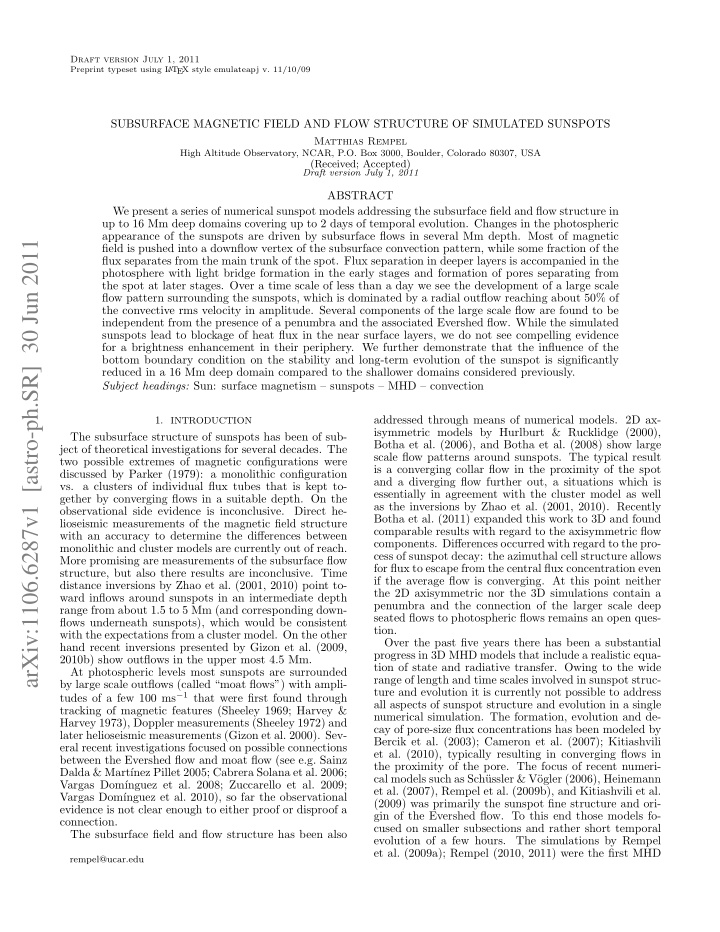



Draft version July 1, 2011 Preprint typeset using L T EX style emulateapj v. 11/10/09 A SUBSURFACE MAGNETIC FIELD AND FLOW STRUCTURE OF SIMULATED SUNSPOTS Matthias Rempel High Altitude Observatory, NCAR, P.O. Box 3000, Boulder, Colorado 80307, USA (Received; Accepted) Draft version July 1, 2011 ABSTRACT We present a series of numerical sunspot models addressing the subsurface field and flow structure in up to 16 Mm deep domains covering up to 2 days of temporal evolution. Changes in the photospheric appearance of the sunspots are driven by subsurface flows in several Mm depth. Most of magnetic arXiv:1106.6287v1 [astro-ph.SR] 30 Jun 2011 field is pushed into a downflow vertex of the subsurface convection pattern, while some fraction of the flux separates from the main trunk of the spot. Flux separation in deeper layers is accompanied in the photosphere with light bridge formation in the early stages and formation of pores separating from the spot at later stages. Over a time scale of less than a day we see the development of a large scale flow pattern surrounding the sunspots, which is dominated by a radial outflow reaching about 50% of the convective rms velocity in amplitude. Several components of the large scale flow are found to be independent from the presence of a penumbra and the associated Evershed flow. While the simulated sunspots lead to blockage of heat flux in the near surface layers, we do not see compelling evidence for a brightness enhancement in their periphery. We further demonstrate that the influence of the bottom boundary condition on the stability and long-term evolution of the sunspot is significantly reduced in a 16 Mm deep domain compared to the shallower domains considered previously. Subject headings: Sun: surface magnetism – sunspots – MHD – convection addressed through means of numerical models. 2D ax- 1. INTRODUCTION isymmetric models by Hurlburt & Rucklidge (2000), The subsurface structure of sunspots has been of sub- Botha et al. (2006), and Botha et al. (2008) show large ject of theoretical investigations for several decades. The scale flow patterns around sunspots. The typical result two possible extremes of magnetic configurations were is a converging collar flow in the proximity of the spot discussed by Parker (1979): a monolithic configuration and a diverging flow further out, a situations which is vs. a clusters of individual flux tubes that is kept to- essentially in agreement with the cluster model as well gether by converging flows in a suitable depth. On the as the inversions by Zhao et al. (2001, 2010). Recently observational side evidence is inconclusive. Direct he- Botha et al. (2011) expanded this work to 3D and found lioseismic measurements of the magnetic field structure comparable results with regard to the axisymmetric flow with an accuracy to determine the differences between components. Differences occurred with regard to the pro- monolithic and cluster models are currently out of reach. cess of sunspot decay: the azimuthal cell structure allows More promising are measurements of the subsurface flow for flux to escape from the central flux concentration even structure, but also there results are inconclusive. Time if the average flow is converging. At this point neither distance inversions by Zhao et al. (2001, 2010) point to- the 2D axisymmetric nor the 3D simulations contain a ward inflows around sunspots in an intermediate depth penumbra and the connection of the larger scale deep range from about 1 . 5 to 5 Mm (and corresponding down- seated flows to photospheric flows remains an open ques- flows underneath sunspots), which would be consistent tion. with the expectations from a cluster model. On the other Over the past five years there has been a substantial hand recent inversions presented by Gizon et al. (2009, progress in 3D MHD models that include a realistic equa- 2010b) show outflows in the upper most 4 . 5 Mm. tion of state and radiative transfer. Owing to the wide At photospheric levels most sunspots are surrounded range of length and time scales involved in sunspot struc- by large scale outflows (called “moat flows”) with ampli- ture and evolution it is currently not possible to address tudes of a few 100 ms − 1 that were first found through all aspects of sunspot structure and evolution in a single tracking of magnetic features (Sheeley 1969; Harvey & numerical simulation. The formation, evolution and de- Harvey 1973), Doppler measurements (Sheeley 1972) and cay of pore-size flux concentrations has been modeled by later helioseismic measurements (Gizon et al. 2000). Sev- Bercik et al. (2003); Cameron et al. (2007); Kitiashvili eral recent investigations focused on possible connections et al. (2010), typically resulting in converging flows in between the Evershed flow and moat flow (see e.g. Sainz the proximity of the pore. The focus of recent numeri- Dalda & Mart´ ınez Pillet 2005; Cabrera Solana et al. 2006; cal models such as Sch¨ ussler & V¨ ogler (2006), Heinemann Vargas Dom´ ınguez et al. 2008; Zuccarello et al. 2009; et al. (2007), Rempel et al. (2009b), and Kitiashvili et al. Vargas Dom´ ınguez et al. 2010), so far the observational (2009) was primarily the sunspot fine structure and ori- evidence is not clear enough to either proof or disproof a gin of the Evershed flow. To this end those models fo- connection. cused on smaller subsections and rather short temporal The subsurface field and flow structure has been also evolution of a few hours. The simulations by Rempel et al. (2009a); Rempel (2010, 2011) were the first MHD rempel@ucar.edu
Recommend
More recommend